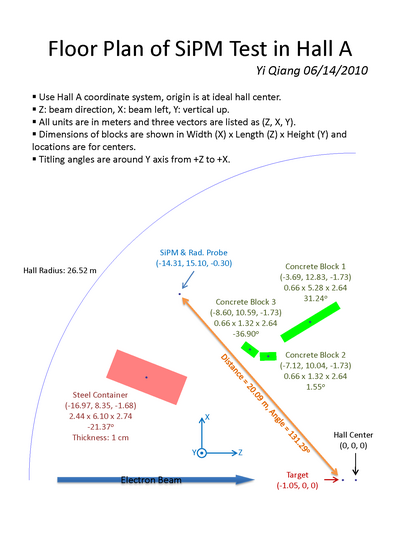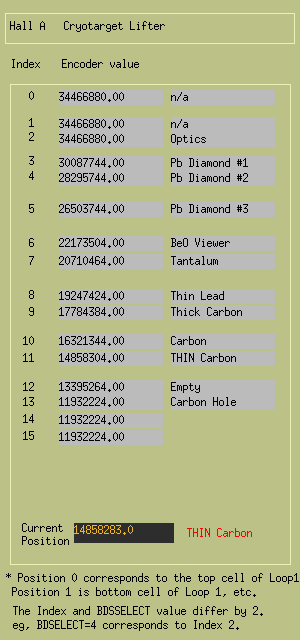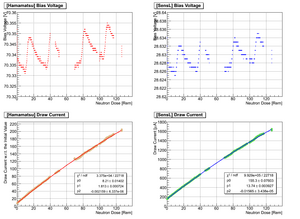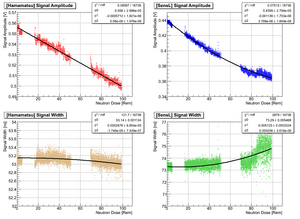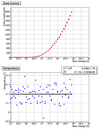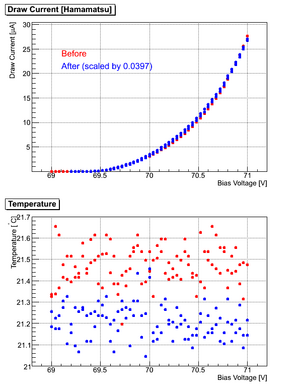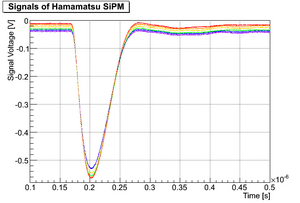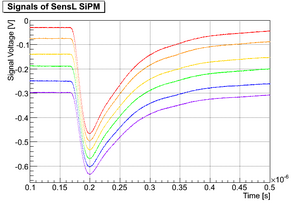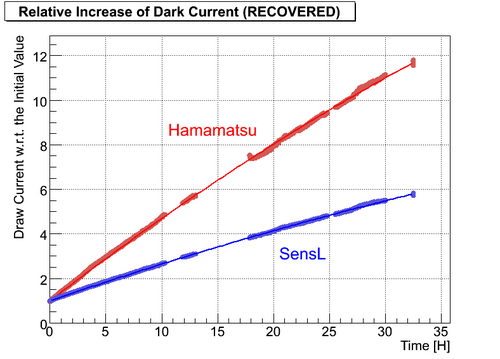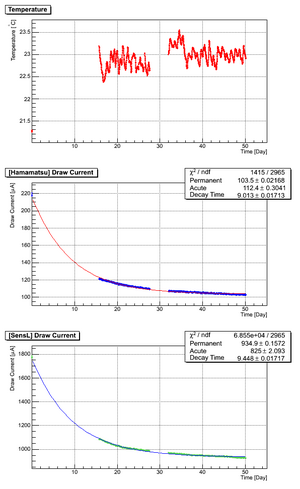Difference between revisions of "SiPM Radiation Hardness Test"
From GlueXWiki
m (→Plots) |
(→Facts and Conclusions) |
||
| Line 163: | Line 163: | ||
<br clear=all> | <br clear=all> | ||
| − | + | === Facts and Conclusions === | |
* Hall A radiation level is extremely high during P-REX experiment: 50uA on 0.5mm Pb target ('''9%''' radiation length). | * Hall A radiation level is extremely high during P-REX experiment: 50uA on 0.5mm Pb target ('''9%''' radiation length). | ||
Revision as of 11:40, 17 June 2010
SiPM Radiation Hardness Test in Hall A
Test Plan
The Draft Test Plan to Study Radiation Damage to SiPMs in Hall A
System Diagram and Floor Plan
Device List
- Control Computer: transversity.jlab.org: (129.57.164.28)
- GPIB over IP: GPIB-ENET/100: agpib.jlab.org (129.57.192.73)
- Serial Port Server: ESP904: portservha50.jlab.org (129.57.192.78)
- USB over IP: AnywhereUSB/5: ausb.jlab.org (129.57.192.75)
- Oscilliscope: TDS3034: dosci.jlab.org (129.57.192.77)
- Power Outlet: APC Outlet Control: hlauser:hlauser@hareboot12.jlab.org (129.57.192.76)
- Outlet 1: Pulse Generator
- Outlet 2: Temperature Box
- Outlet 3: Oscilliscope
- Outlet 4: GPIB over IP
- Outlet 5: Power Supply for Hamamatsu Unit
- Outlet 6: Power Supply for SensL Unit
- Outlet 7: Picoamp Meter
- Outlet 8: Serial Port Server
- USB to Serial HUB: ComHUB
- Serial 1 (COM5): Power Supply for Hamamatsu Unit
- Serial 2 (COM6): Power Supply for SensL Unit
- Serial 3 (COM7): Oscilliscope
- Serial 4 (COM8): Temperature Box
- Picoamp Meter x2: Keithley-485 (GPIB)
- GPIB Address: 1 (Hamamatsu); 2 (SensL)
- Pulse Generator: HP-8116A (GPIB)
- GPIB Address: 4
- Power Supply x2: B&K-1787B (RS232)
- Temperature Meter: CN77544 (RS232)
Power Connection and Settings
- Power Cable Color Code
- Black: Ground
- Yellow: -5.0 V
- Red: +2.1 V
- Blue: Hamamatsu Bias Voltage
- Green: SensL Bias Voltage
- SiPM Bias Voltage Correction vs Temperature
- Hamamatsu: 56 mV/C (70.27 at 20 C)
- SensL: 23 mV/C (28.6 at 20 C)
EPICS Variables
Hall A Beam Line IOC: iocha5.jlab.org [129.57.188.5]
- hac_bcm_average: Hall A beam current (uA)
Hall A Cryo Target IOC: iocha13.jlab.org [129.57.188.29]
- haBDSPOS.VAL: Hall A cryo target position (encoder value)
MCC general IOC: 129.57.255.4
- rad44_p2: Neutron dose [mRem/hour]
- rad44_p2_dose: Accumulated Neutron dose [mRem]
- rad44_p1: Gamma dose [mRem/hour]
- rad44_p1_dose: Accumulated Gamma dose [mRem]
SiPM Test Log
3x3 mm2 SiPM Test in Hall A
Test Condition
- Time: 04/20/2010 12:30 PM
- Location: Hall A beam left
- Initial Dose
- Neutron (rad44_p2) 18.4 mRem
- Gamma (rad44_p1) 61900 mRem
- Radiation Chips
- Neutron Rod: serial# 2A01 close to SiPM
- TLD: serial# 9597, close to SiPM and rad44_p2
- TLD: serial# 9598, close to rad44_p1 at entrance
Pre-Rad Measurement
- Voltage vs Current scan done
- Hamamatsu: 20100420_132141_VICurve.txt
- Hamamatsu: 20100420_132531_VICurve.txt
- SensL: 20100420_132531_VICurve.txt
- SensL: 20100420_132531_VICurve.txt
Beam ON Test
- Oscilloscope Snapshot #1: 20100420_135400_CHx.txt
- Oscilloscope Snapshot #2: 20100421_014000_CHx.txt
- Oscilloscope Snapshot #3: 20100421_091100_CHx.isf
- Oscilloscope Snapshot #4: 20100421_182200_CHx.isf
- Oscilloscope Snapshot #5: 20100422_015300_CHx.isf
- Oscilloscope Snapshot #6: 20100422_102700_CHx.isf
- Dataset #1: 20100420_140630.txt
- Stopped due to GIPB problem
- No production
- Dataset #2: 20100420_182713.txt
- Long run with production started
- 22:40:30 - 01:46:10 oscilloscope not updating
- Stopped due to GPIB problem
- Dataset #3: 20100421_091253.txt
- Stopped due to EPICS problem
- Dataset #4: 20100421_105132.txt
- HV OFF at 10:59:00 to test radiation damage with bias voltage OFF
- Stopped to turn bias voltage back ON at 18:21:00
- Dataset #5: 20100421_182344.txt
- New dataset with bias voltage ON
- Stopped due to GPIB problem
- Dataset #6: 20100422_015736.txt
- Stopped due to GPIB problem
- Dataset #7: 20100422_091215.txt
- Beam OFF
- oscilloscope not updating
Post-Rad Measurement
- Voltage vs Current scan done
- Hamamatsu: 20100422_105000_VICurve.txt
- Hamamatsu: 20100422_105334_VICurve.txt
- SensL: 20100422_105732_VICurve.txt
- SensL: 20100422_110249_VICurve.txt
Plots
- Change of draw Current and signal shape at working condition as a function of radiation
- Comparison of VI response before and after radiation
- Signals recorded by oscilloscope show the effect of radiation on amplification: red (initial) -> violet (final)
- If we take the dose to fluence coefficient of 1 MeV Neutron: 400 pSv.cm2 = 4x10-8 rem.cm2, we have the following plot
Aneeling of Radiation Damage
Facts and Conclusions
- Hall A radiation level is extremely high during P-REX experiment: 50uA on 0.5mm Pb target (9% radiation length).
- A lot of excessive radiation is created by the 2 pieces of collimator behind Pb Target: estimated 1 kiloWatt total power dissipated on them.
- The neutron dose rate before the collimator installed was 1.55 rem/H with 45 uA beam on Pb target. After the collimator was installed, the dose rate during the SiPM test was 1.35 rem/H with 50 uA beam. Therefore the tungsten collimator did not significantly change the radiation level.
- Radiation causes draw current to increase no matter whether bias voltage is applied.
- Hamamatsu: starting from 8 uA, 5 uA/Rem
- SensL: starting from 155 uA, 40 uA/Rem
- The dark current from both SiPM samples recovered by about half with time constant of 10 days
- Taking the bias voltage adjustment into account, the dark current has an exponential relation with ambient temperature:
- I(dark) ~ exp(a*(T-T0))
- a for Hamamatsu: 0.061+-0.003/C
- a for SensL: 0.047+-0.002/C
- Radiation slowly affects the amplification of SiPM but has no effect on the signal width, even though, the drops of the gain get fully recovered afterward.
- Report to GlueX meeting (2010/05/10): link to docDB
- Dark rate measurement shows a increase of noise level consistent with the increase of dark current:Carl's report
- I(dark) ~ Sigma(pedestal)^2
Translate Simulation Results
- Detectors were put 20 meters away from Pb target and 135 degrees backward.
- Simulation was done by Pavel Degtiarenko by only considering the 0.5 mm Pb target in Hall A.
- Neutron dose equivalent conversion coefficients were taken from ICRP 74, plot see [1], may off by a factor of 2.
- Displacement damage in silicon was taken [2], as recommended for LHC silicon detector study.
- By combining all information we got:
- Biological dose rate: 0.12 rem/H
- 1 MeV equivalent neutron fluence: 1050 Hz/cm2
- About a factor of 10 smaller than we measured in the Hall.
- Plots are shown here:
ToDo List
- Annealing test
- Translate Rem to equivalent neutron fluence
- Estimate life time in Hall D condition
1x1 mm2 SiPM Test in Hall A
Test Condition
- Same location as previous 3x3 SiPM test: 135 degrees, 20 meters
- Not powered
- Temperature: ~ 21.3 degree C
- SiPM information:
- Type Number: S10362-11-050C
- Serial Number: 1260
- Vop: 71.54 V
- M: 7.50e+5
- Dark Rate (0.5 p.e.): 536 kcps
- Dark Rate (1.5 p.e.): 44 kcps
- X-talk: 8.2%
- PDE (lambda = 490 nm): 36.5%
- At 25 degree C
Initial Neutron Dose 2010/06/11 11:20 AM
- rad44_p2_dose: 0 Rem

